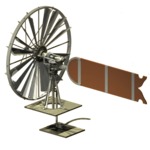
 Cliquez pour agrandir Cliquez pour agrandir
|
Description
Compressor 1 delivers compressed air into tank 2. Relief valve 3 maintains a constant air pressure in the system. Braking is performed by depressing the pedal of brake valve 5, connected to the air tank and to brake chambers 6, which apply the rear wheel brakes. Valve 5 is connected through rapid-release valve 7 to brake chambers 8 of the front wheels. The purpose of rapid-release valve 7 is to discharge the air from the front brake chambers as rapidly as possible to the atmosphere, by-passing brake valve 5. When the brake pedal is depressed, compressed air from the tank is directed to the brake chambers of the rear and front wheels, braking the bus. When the pedal is released, air from the rear brake chambers is discharged to the atmosphere through brake valve 5; air from the front brake chambers is discharged to the atmosphere directly through rapid-release valve 7. Pressure regulator 4 switches the compressor over to idle running.
$4294$CHP,Br$
|

 Cliquez pour agrandir
Cliquez pour agrandir








 GERMANY
GERMANY SPAIN
SPAIN ROMANIA
ROMANIA FRANCE
FRANCE ITALY
ITALY